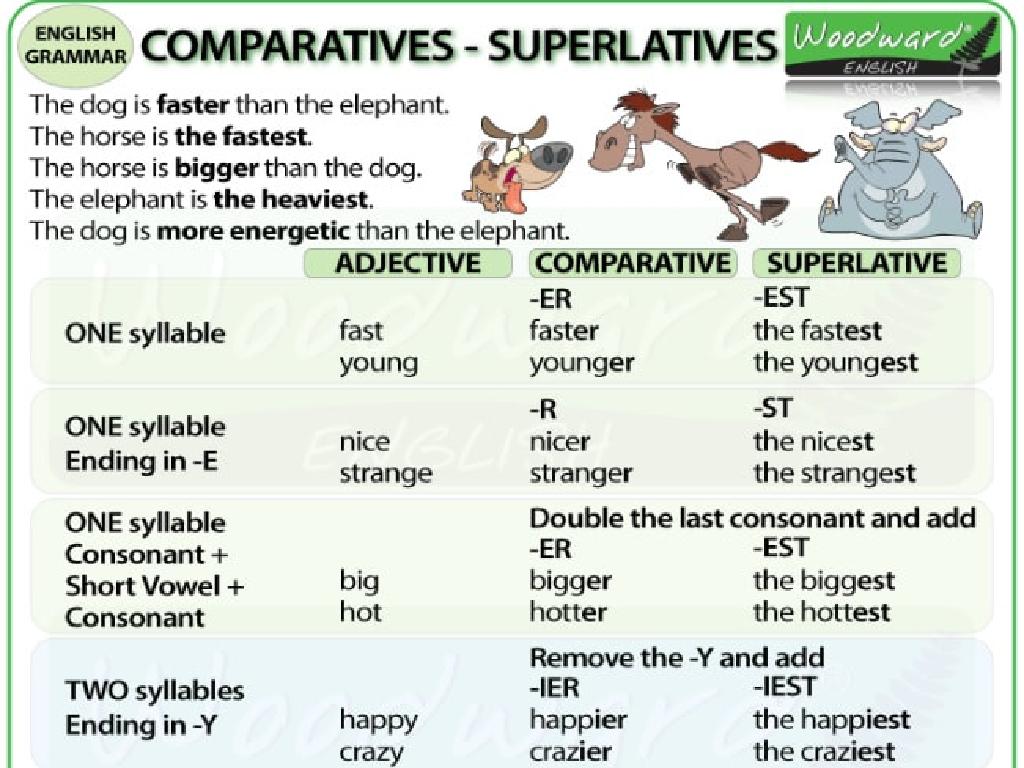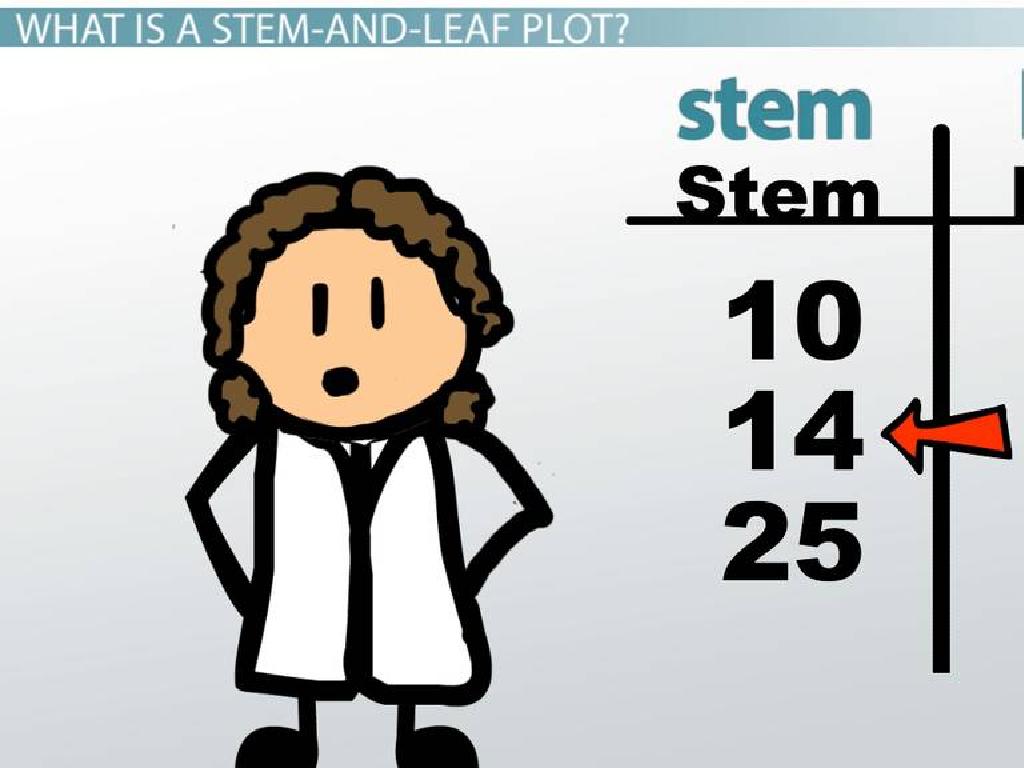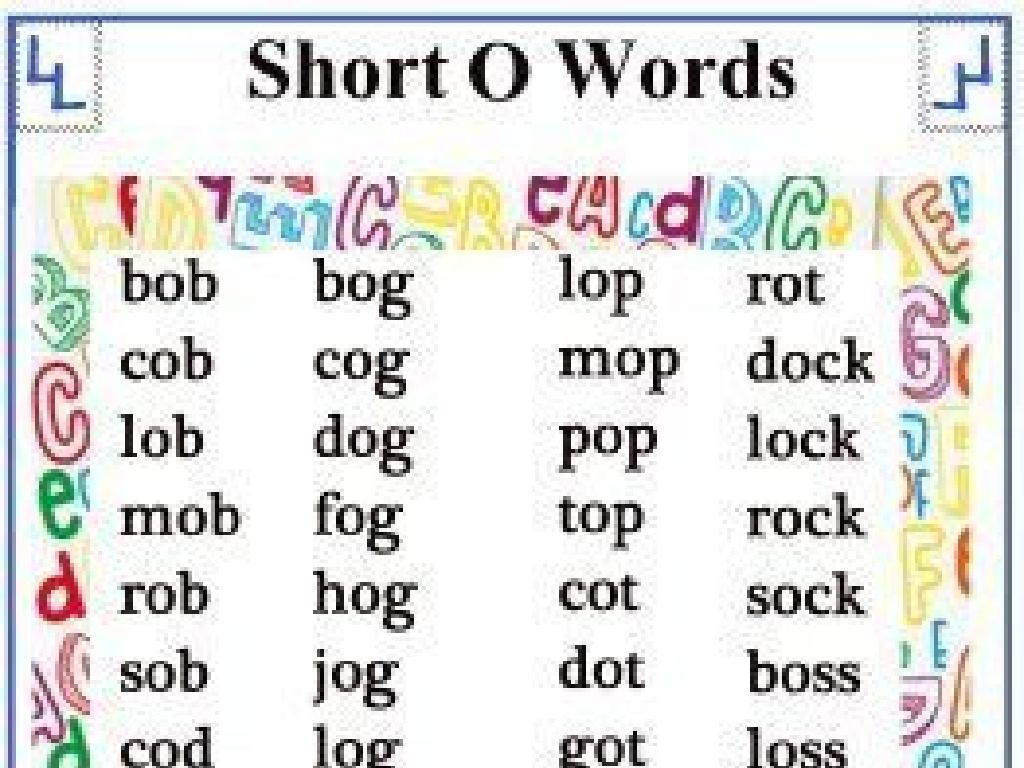Identify The Complete Predicate Of A Sentence
Subject: Language arts
Grade: Fourth grade
Topic: Sentences, Fragments, And Run-Ons
Please LOG IN to download the presentation. Access is available to registered users only.
View More Content
Understanding Sentence Structures
– What makes a complete sentence?
A subject and a predicate make a full sentence.
– Spotting sentence fragments
Fragments are incomplete thoughts without predicates.
– Recognizing run-on sentences
Run-ons are sentences that need to be split up.
– Finding the complete predicate
The predicate tells what the subject does or is.
|
This slide introduces students to the basic components of sentences and how to identify common errors such as fragments and run-ons. Emphasize the importance of both a subject and a predicate to form a complete sentence. Explain that fragments are missing a subject or predicate and cannot stand alone, while run-ons contain too many ideas without proper punctuation. Focus on the complete predicate, which includes the verb and all the words that tell more about the subject’s action or condition. Use examples to illustrate each point and encourage students to create their own sentences, identifying subjects and predicates.
Understanding Sentences: Subjects and Predicates
– Definition of a sentence
– A sentence shares a complete idea with words.
– Two main parts: subject and predicate
– Every sentence splits into two essential parts.
– Subject: ‘who’ or ‘what’
– The subject is the focus of the sentence.
– Predicate: ‘what about it’
– The predicate explains the action or state of the subject.
|
This slide introduces the basic components of a sentence to help students identify and understand complete predicates. Begin by defining a sentence as a collection of words that conveys a full thought. Explain that every sentence is made up of a subject and a predicate. The subject is the person, place, thing, or idea that the sentence is about, while the predicate provides information about what the subject is doing or what condition the subject is in. Use examples to illustrate these concepts, such as ‘The dog (subject) barked loudly (predicate).’ Encourage students to practice by identifying subjects and predicates in sample sentences.
Breaking Down Sentences: Subjects and Predicates
– Understanding sentence structure
– Example: Subject and Predicate
– ‘The dog’ is the subject, ‘ran across the yard’ is the predicate
– Activity: Identify subject and predicate
– Find the subject and predicate in: ‘The cat sat on the mat.’
– Practice makes perfect
|
This slide introduces the basic components of sentence structure to the students, focusing on the subject and predicate. Start by explaining that every sentence has two main parts: the subject, which tells us who or what the sentence is about, and the predicate, which tells us what the subject is doing. Use the example provided to illustrate these parts clearly. For the activity, encourage students to identify the subject and predicate in a new sentence. This will help them understand how to break down sentences and improve their grammatical skills. Provide guidance and be ready to offer hints if they struggle. After the activity, emphasize the importance of practice in mastering this concept.
Understanding the Predicate
– Predicate: Action or state of subject
– Includes verb and related information
– Verb: ‘runs’ in ‘The dog runs fast.’
– Complete predicate excludes subject
– ‘Runs fast’ is the predicate without ‘The dog’.
– Examples to clarify predicates
– ‘The cat is sleepy.’ Predicate: ‘is sleepy’
|
This slide introduces the concept of the predicate as part of a sentence structure. The predicate is essential as it tells us what the subject is doing or what state it is in. It includes the main verb and can also include other words that describe or give more information about the action of the verb. To identify the complete predicate, students should look for everything in the sentence that is not the subject. Use examples to illustrate the concept, such as ‘The dog runs fast’ where ‘runs fast’ is the predicate. Encourage students to practice by identifying predicates in different sentences and explain that understanding predicates helps in recognizing complete sentences versus fragments.
Finding the Complete Predicate
– What is a complete predicate?
The part of the sentence that tells what the subject does or is.
– It’s all except the subject
– Example: ‘The children played…’
In ‘The children played at the park until dinner’, ‘played at the park until dinner’ is the predicate.
– Practice identifying predicates
We’ll look at sentences and find the predicates together.
|
This slide introduces the concept of the complete predicate to the students. Begin by explaining that the complete predicate includes the verb and all the words that tell more about what the subject is doing or what is happening to the subject. It’s everything in the sentence except the subject itself. Use clear examples to illustrate this, such as the provided sentence about the children playing. Encourage students to practice by identifying the complete predicate in various sentences. This activity will help them understand sentence structure and improve their grammar skills. Make sure to provide immediate feedback during practice to reinforce learning.
Your Turn: Finding the Predicate!
– I’ll provide sentences for you
– Identify all the predicates
– The part of the sentence that tells what the subject does or is like
– Discuss with your partner
– Explain your thoughts and listen to your partner’s ideas
– Share your findings in class
|
This slide is designed to engage students in a collaborative activity where they will practice identifying the complete predicate in various sentences. The complete predicate includes the verb and all the words that tell what happened in the sentence or describe the subject. Encourage students to work together, discussing their reasoning for each predicate they identify. This will help them understand the concept better and learn from each other. After the activity, ask volunteers to share their sentences and identified predicates with the class to reinforce learning. Possible activities could include identifying predicates in sentences from a storybook, writing their own sentences and exchanging them with a partner, or finding predicates in sentences around the classroom.
Understanding Sentences, Fragments, and Run-ons
– What makes a complete sentence?
A sentence must have a subject (who or what) and a predicate (what about it).
– Identifying sentence fragments
Fragments lack a subject or predicate, like ‘After the rain’ with no action.
– Recognizing run-on sentences
Run-ons are like ‘I love to swim I go every day’ without proper separation.
– Correcting fragments and run-ons
We can fix fragments and run-ons by adding missing parts or punctuation.
|
This slide introduces the concept of complete sentences versus fragments and run-ons. A complete sentence expresses a complete thought with both a subject and a predicate. Fragments and run-ons are common mistakes in writing. Fragments are incomplete because they’re missing either a subject or a predicate, leaving a thought unfinished. Run-ons occur when two sentences are improperly joined without the correct punctuation or conjunctions. Teaching students to identify and correct these errors is crucial for their writing skills. Use examples to illustrate each point and provide exercises where students can practice distinguishing between complete sentences, fragments, and run-ons.
Class Activity: Sentence Detectives
– Become a sentence detective!
– Mission: Spot sentences and fragments
– A sentence has a complete thought, but a fragment doesn’t.
– Find and mark run-on sentences
– Run-ons are sentences that need to be split up.
– Use subjects and predicates as clues
– Remember, every sentence has a subject and a predicate.
|
In this engaging class activity, students will apply their knowledge of sentence structure by identifying complete sentences, fragments, and run-on sentences in a provided worksheet. Encourage them to use the concept of subjects and predicates as clues to determine the structure of each example. For complete sentences, they should be able to find both a subject and a predicate that conveys a complete thought. Fragments will be missing one of these elements, and run-on sentences will have too many ideas without proper punctuation or conjunctions. Provide guidance on how to correct fragments and run-ons. Prepare a worksheet with a mix of all three types for the students to work on, and consider creating a fun detective-themed atmosphere to make the activity more engaging.
Review and Reflect: Complete Predicates
– Recap on complete predicates
– The part of the sentence that tells what the subject does or is like
– Importance of identifying predicates
– Understanding predicates can make our sentences clear and complete
– Share an interesting lesson takeaway
– Each student thinks of one aspect of predicates they found intriguing
|
This slide aims to consolidate the day’s learning about complete predicates. Start by reviewing the definition of a complete predicate, which includes the verb and all the words that tell more about the action or state of the subject. Discuss how identifying predicates can improve writing by ensuring sentences are complete and ideas are clearly expressed. Encourage students to reflect on the lesson and share one point about predicates that they found particularly interesting or surprising. This reflection helps reinforce their understanding and allows them to appreciate the nuances of sentence construction. As an activity, students could write sentences and identify the predicates or create sentences with interesting predicates to share with the class.
Homework Challenge: Predicates and Sentence Structure
– Write 5 sentences about your day
– Underline the complete predicate
– The part of the sentence that tells what the subject does or is like
– Find fragments or run-ons in a book
– Look for incomplete or overly long sentences
– Get ready to discuss in class
|
This homework assignment is designed to reinforce the day’s lesson on identifying the complete predicate in a sentence. Students will apply their knowledge by writing sentences about their day and underlining the predicates. Additionally, they will analyze a paragraph from a book of their choice to identify sentence fragments and run-on sentences. This exercise will help them understand sentence structure and improve their writing skills. In the next class, be prepared to facilitate a discussion where students share their sentences and findings, providing feedback and further clarification as needed.






